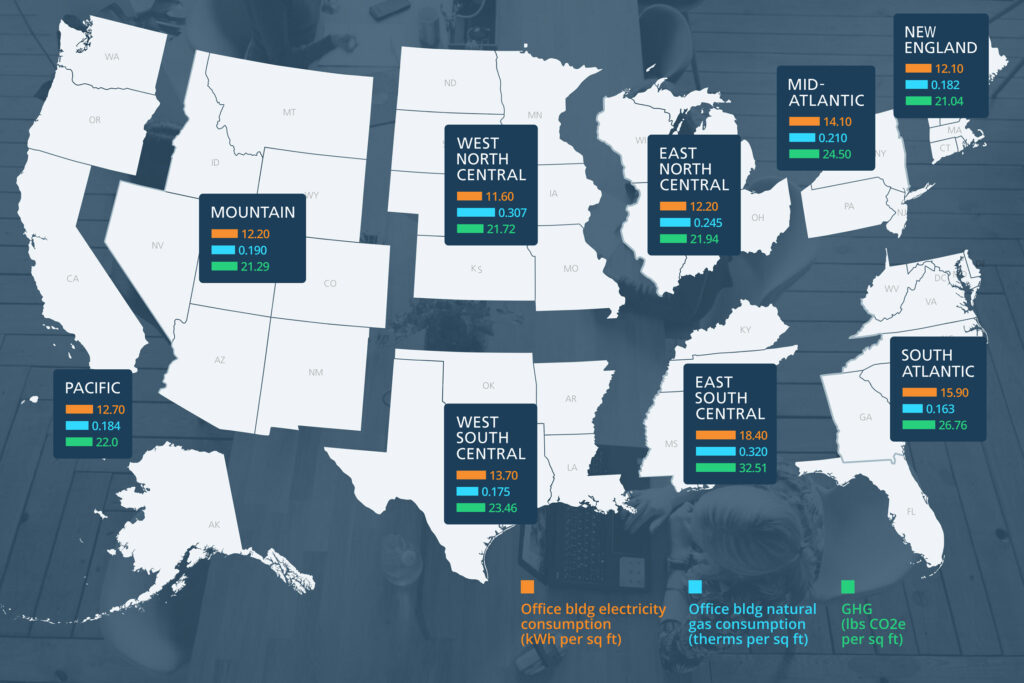
Sustainability In Practice—Using Utilization Data to Calculate Energy and Emissions Reduction Opportunities
Carbon reduction and energy efficiency are subjects we care deeply about at R-Zero. We want to help break down the silos that occupancy data traditionally resides in and apply it toward initiatives that are meaningful for the entire business. As such, we have built some basic calculations that can help organizations understand their emissions and link space reduction or dimming plans to sustainability and ESG reporting. These calculations are generalized and allow for significant variability that accommodates your location, program, and size.
What Is Our Sustainability Calculator?
R-Zero pulled data from all 50 states on electricity in $/kWH and natural gas in $/Therms. We then pulled data on 9 different census regions to establish baseline electricity and natural gas consumption per square foot. These regions are New England, Middle Atlantic, East North Central, West North Central, South Atlantic, East South Central, West South Central, Mountain, and Pacific. Based on these figures, each region has a greenhouse gas (GHG) emission number per square foot in tonnes or pounds.

Of these regions, the East South Central uses the most electricity (an average of 18.4 kWh per square foot of office space), AND the most natural gas (0.32 therms per square foot). Though it is not the most expensive region, it does consume the most. This should come as no surprise as utilities like air conditioning are used heavily in this region, for example. Together, the gas and electricity fixtures equal GHG emissions of about 0.0147 tonnes of CO2 per square foot—or about 32.51 pounds. Considering that the UN Environment Program estimates that buildings account for 38% of U.S. emissions, even modest improvements in office space efficiency represent a huge opportunity for sustainability.
And that’s not all. Using the same region, an office building in Mississippi would pay an average of $0.13 per kWh of electricity and $1.48 per therm of natural gas. This means that those emissions are costing approximately ($2.40+$0.47) $2.87 per square foot. While that might sound minuscule, consider that the average office building in Jackson, Mississippi alone is almost 150,000 square feet—meaning a company renting that building can expect to pay $430,500 in utilities alone every year.
Put it all together, and our sustainability calculator estimates that this hypothetical company is producing 2.2k tonnes of CO2e annually, or the equivalent of 481 cars on the road, just to operate the facility.
Where Do Occupancy Sensors Come Into Play?
To design a truly efficient workspace that supports or elevates productivity, companies need data—and that’s where occupancy sensors play an important role.
Let’s use another example from the energy sustainability calculator.
Say a tech company in California is renting a 1 million square foot building. At an average cost of electricity in that state is $0.24/kWH and an average natural gas rate of is$1.67/Therm, that company is spending around $3.3M in energy costs to support their staff in that space each year.
Some companies may use motion sensors, badge data, or average indoor environmental data to more intelligently drive their HVAC system towards efficiency. However, these data sources tend to be low in granularity and may not be available in real-time. Modern HVAC systems can accommodate real-time granular data that can drive significant improvements in efficiency.
R-Zero’s occupancy sensors give customers a very accurate count of the number of spaces occupied at any point in time across all floors, across all space types, and at all densities. By leveraging this data, companies can predict spatial needs by seeing how often these spaces go unused with the number of employees they have in the building, creating a data-backed case for downsizing or dimming office space.
If our hypothetical tech company found that even a 20% reduction of space was possible, that company would stand to save an estimated $671,056 on utilities per year, as well as 1,996 tonnes of CO2—the equivalent of taking 434 cars off the road forever.
If this company determined that they could simply shut down 33% of their space on Mondays and Fridays, a practice called “dimming,” then they stand to save $327k/year in energy costs and 973 tonnes of CO2e or remove 212 cars from the road. Additional savings across space reduction or dimming practices can be achieved as maintenance and repairs, cleaning costs, and others like parking and grounds are identified as additional cost factors. In the dimming example above, an additional $3.55M can be saved annually by dimming the space.
Once these initiatives are realized, further efficiencies can still be achieved. According to Constellation, 17% of electricity usage in the building goes toward lighting. Running your lighting and HVAC systems based on real-time occupancy data can help achieve incremental savings that are crucial to ongoing ESG reporting.
Making Data Work for You—and the Planet
Real estate emissions are a significant problem to solve, but thanks to smart technology we can stop treating buildings with a one-size-fits-all approach. Sensor data collection from R-Zero ’s occupancy sensors gives you the kind of tools to make informed space-management decisions, and finding solutions with an ROI perspective can help organizations take meaningful action against energy costs and high-stakes GHG emissions.
Get in touch today to learn more about our data sources and for a more specific estimate of your company’s emissions!

